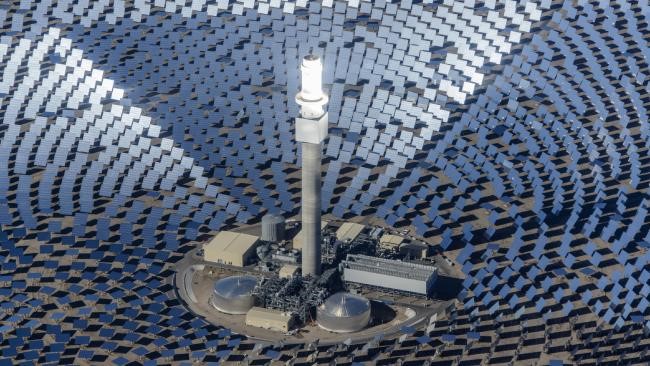The notion of establishing a viable solar-thermal power plant in Australia was raised by the renewable energy think tank Beyond Zero Emissions (BZE) as far back as 2010 . In 2012 plans for such a power plant were firmed up by BZE and the Repower Port Augusta campaign came into existence .
During the intervening 5 years between then and now, a peoples’ movement in collaboration with scientists, engineers and local government lobbied the South Australian government relentlessly with powerful, logical and well backed up arguments for constructing a concentrated solar-thermal power plant in Port Augusta to replace the existing system of coal-fired power plants which was coming to the end of its life. The idea was widely supported throughout South Australia, but it was the people of Port Augusta who played a pivotal part in the campaign. In the process, the people developed and honed their skills and strategies in united front work. There was involvement of ordinary citizens of Port Augusta, workers from the power plant, local government, local businesses and city people (Adelaide). Pt Augusta residents took action online, crowdfunded TV ads and billboards, doorknocked and had thousands of conversations. They rallied in the streets, and 100 of them even walked from Port Augusta to Adelaide to make their voices heard.
The success of the campaign was never a given, especially considering that those behind the push for more traditional and environmentally unacceptable methods of electricity generation have loud political and financial voices. This makes the victory all the more significant and demonstrates what can be achieved by the people when they unflinchingly stand united.
The basic principal of operation of a concentrated solar-thermal power station is as follows. A large array of mirrors tracks the transit of the sun across the sky during the day. The reflected radiation is focused on to a tower, the top part of which is filled with sodium chloride – the common salt that we eat with our food and that exists in sea water. The focused radiation is sufficiently intense that the salt becomes molten. The molten salt contains large amounts of stored energy (look mum, no batteries!) which can be called upon as required to generate electricity in the same way that the last stage of conventional electricity generation does. Namely, the energy is used to heat water to produce steam which drives turbines which in turn generate the electricity.
This type of solar-thermal power generation is proven technology with such plants having been in use for example in Spain since 2011 and in Nevada in the USA.
One argument that was posed by those against the case for a concentrated solar-thermal power plant for Port Augusta when the idea was first put forward, was that it would not be able to cater for periods of peak electricity demand. This is no longer an issue in the latest designs. The proposed plant is capable of generating 150MWatts and the maximum load requirement set by the government is 125MWatts. The excess capacity during daylight hours can be fed back into the grid. The heat that is stored in the molten salt can generate electricity for about another 8 hours after the sun goes down.
A single solar-thermal plant is not sufficient to provide all of South Australia’s energy presently but it will be part of a mix with other renewables including wind, solar photovoltaic and lithium ion battery storage; and unfortunately for the moment, non-renewable gas.
However, the construction of even a single solar-thermal plant is highly significant. The first one always has the greatest cost associated with it. As an industry develops around this type of plant, the cost of subsequent plants will reduce and the uptake of the technology will increase. Part of the deal is to involve South Australian universities in conducting further research on solar-thermal systems.
In this way, and as other renewable technologies develop, the transition to 100% renewable energy forms part of reality. The only barrier to achieving this is the will to do so.
The federal government has shown no leadership or commitment toward this reality, but instead dreams up excuses for not going down the path of 100% renewable energy, criticising those who do and it continues to back the dead-end and environmentally damaging fossil fuel industry.
Even poorly funded not-for-profit, but nonetheless professional, think tanks like BZE are showing the way forward with their “Zero Carbon Australia Plan”. They have devised a viable plan, the government has none.
With solar-thermal no longer a pipedream, the federal government must come up with the goods or face being totally discredited and going the way of the dinosaurs.
Had Australia been under socialism, a commitment to 100% renewable energy would have been made long ago as part of a national strategic plan and the requisite research undertaken in earnest before any looming environmental disaster manifests itself. Further still, energy sovereignty would be seen as essential, and energy supply and ownership would be nationalised. There would be no opportunity to either hold the country to ransom or to impose obscene price rises.
The proposed solar-thermal power plant relies on a 20 year contract with US company Solar Reserve for supplying the electricity that is generated.
...................................
1. Zero Carbon Australia Stationary Energy Plan 2010. Published by the Melbourne Energy Institute, University of Melbourne.
2. Repowering Port Augusta. A blueprint to replace Northern and Playford B coal power stations with renewable energy. Published by Beyond Zero Emissions in 2012.

